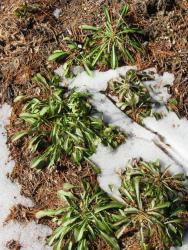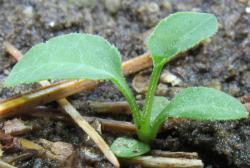
Two weeks after the use of fertilizer, there is not any exciting change. The third leaf (top middle in these photos) grew a tiny bit, stopping at just a bit smaller than the second leaf and the fourth leaf has started (visible in this magnified photo, but not to the naked eye).
The fertilizer seems to have caused a green coating on some of the dirt (algae or moss, not yet enough of it to tell). I don't think I'm over watering. I hope that green stuff is doing no harm.
The many other campanula that are smaller than this one are also growing even slower than this one, so tiny as this one is, it is widening its lead. Some have a first leaf no bigger than the cotyledons and still have no second leaf.
Edit: Just to clarify things I mentioned before: These are indoors in trays in south facing windows, so they are only a little cooler daytime (and warmer nighttime) than the fall period outdoors when the mature plants have their big growth spurt, and they are getting more sun (except for filtering effects of clear glass) than any of the surviving outdoor ones ever got (the outdoor ones that got more sun died quickly).


